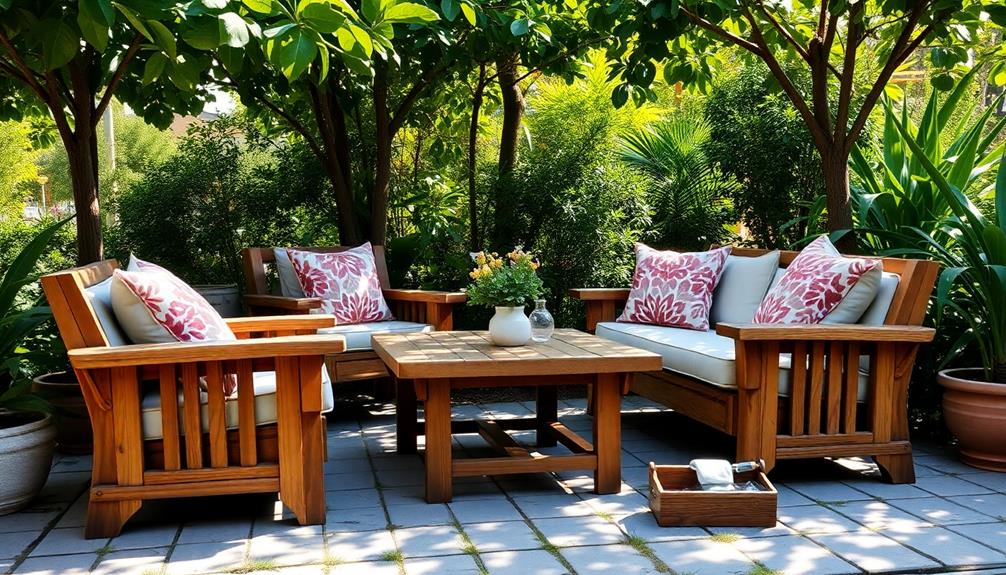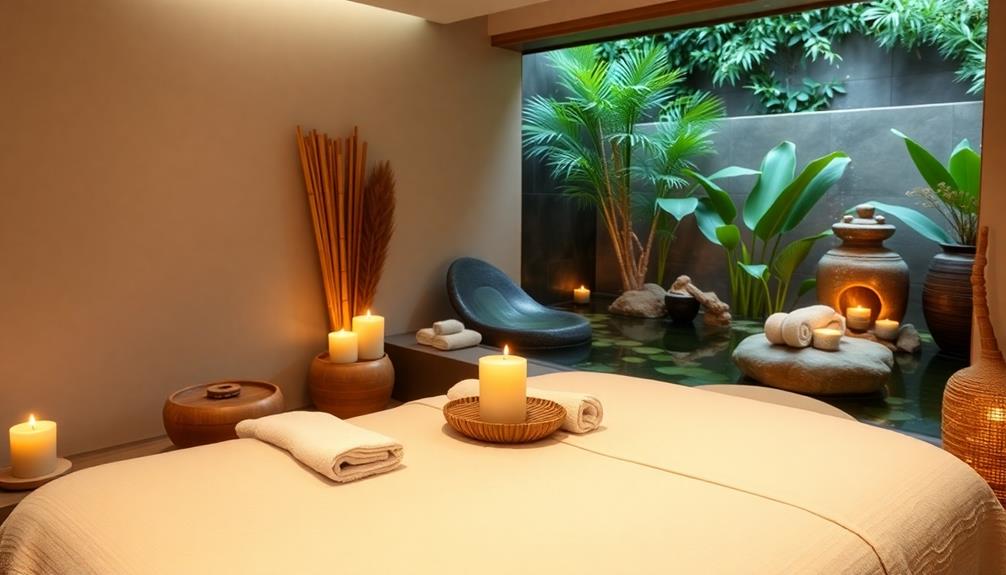To keep your teak outdoor furniture in good condition, begin by regularly cleaning it with a firm bristle brush and diluted dish soap. Make sure to rinse it thoroughly and dry it well to prevent damage from moisture. Immediately attend to any spills by using a soft cloth on mild stains. Apply a teak sealer every 6 to 12 months to shield it from UV rays and moisture. When winter comes, store your furniture in a cool, dry spot away from direct sunlight. Regularly inspect your pieces for signs of wear and mildew to ensure they stay in great condition. There’s a lot more to learn about maintaining that gorgeous teak appearance!
Key Takeaways
- Clean teak furniture regularly with diluted soap and a stiff bristle brush to maintain its appearance and prevent grime buildup.
- Apply teak sealers every 6 to 12 months for long-lasting protection against UV rays and moisture.
- Quickly address spills with a soft cloth to prevent staining, using a stiff brush for stubborn marks.
- Store teak furniture in a dry, shaded area and inspect regularly for signs of wear or mildew.
- Consider professional restoration services for significant damage to enhance longevity and preserve aesthetic integrity.
Importance of Regular Cleaning
To keep your teak outdoor furniture looking its best, regular cleaning is necessary. This isn't just about aesthetics; it's a significant part of teak furniture care that helps maintain its natural appearance and longevity. Aim to scrub your furniture with a stiff bristle brush at least four times a month.
Using a diluted dish soap and warm water solution can help you effectively remove dirt and stains while making sure you follow the wood grain to prevent scratches. Just like maintaining an air purifier, consistent upkeep is key to preserving quality and performance, so don't overlook the importance of routine care in your outdoor furniture maintenance air purifier maintenance dos.
After cleaning, thoroughly dry the furniture to prevent moisture damage and preserve the wood's integrity. Remember, neglecting regular cleaning can lead to the buildup of grime, resulting in dark stains and potential long-term discoloration. The weathering process can take a toll on your furniture, making it important to stay on top of maintenance.
Additionally, consider scheduling annual professional maintenance to guarantee your teak furniture remains in ideal condition. Professionals can address any signs of wear or damage that you might overlook.
Effective Spill Management
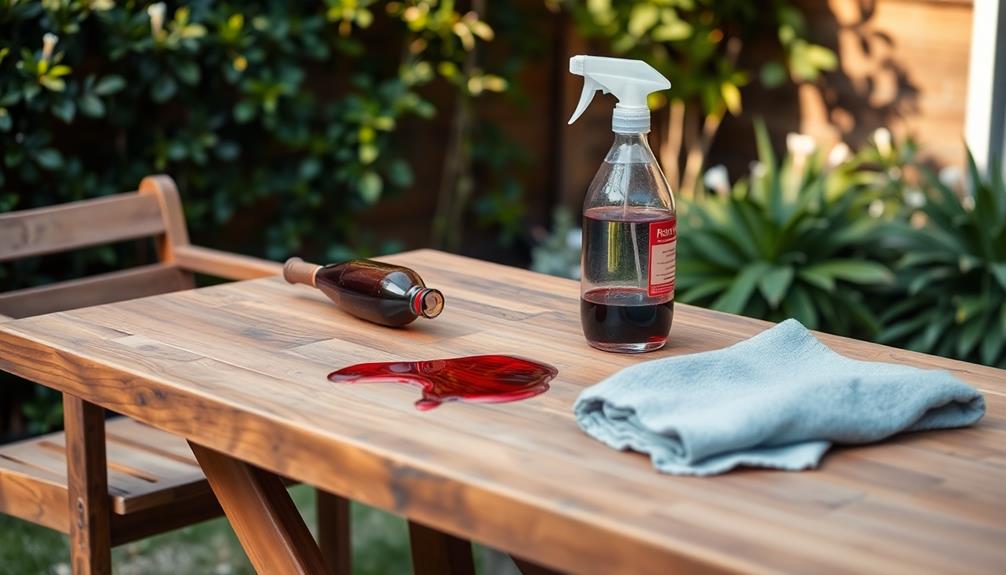
When spills happen, acting quickly is key to preventing stains and damage to your teak furniture.
Keeping a bottle of butter storage tips handy can help guarantee that your furniture remains clean and well-maintained.
For liquid spills, grab a stiff bristle brush or plastic scraper to gently clean up any residue without scratching the surface.
If you notice stubborn stains, a diluted wood cleaner can help restore your furniture's beauty while following the wood grain.
Immediate Cleanup Importance
Immediate cleanup of spills is essential for preserving the beauty and integrity of your teak outdoor furniture. If you let spills sit, you risk staining and permanent damage to the wood. Quick action minimizes potential long-term aesthetic effects and keeps your teak furniture looking its best.
Additionally, just as with proper care for pets, such as ultimate hamster care, staying attentive to your furniture will guarantee it remains in excellent condition for years to come.
For effective spill removal, start by gently lifting the stain with a stiff bristle brush or a plastic scraper. Be cautious not to scratch the surface of the wood. If you encounter stubborn stains, mix diluted water with a specialized wood cleaner to break down the residue. Apply this mixture carefully, making certain you don't oversaturate the wood.
For persistent stains that won't budge, fine-grit sandpaper can help, but steer clear of steel wool or metal brushes as they can cause scratches and further damage.
Stain Removal Techniques
Effective stain removal is key to maintaining the beauty of your teak outdoor furniture. Quick action on spills can save you from stubborn stains and long-term damage.
Here are some stain removal techniques you can use:
- Always use a soft cloth for initial cleanup.
- For gentle stains, try a stiff bristle brush or a plastic scraper, working with the wood grain.
- For tougher marks, a diluted mixture of water and wood cleaner can do wonders.
- Avoid steel wool or metal brushes, as they can scratch and damage the teak surface.
Regular monitoring of your furniture will help you catch spills early.
After cleaning, consider applying teak oils for added protection and to keep your furniture looking its best.
Remember, proper care involves not just cleaning but also maintaining the natural beauty of your clean teak.
With these techniques, you can guarantee your outdoor furniture remains a stunning focal point in your space.
Safe Moving Techniques
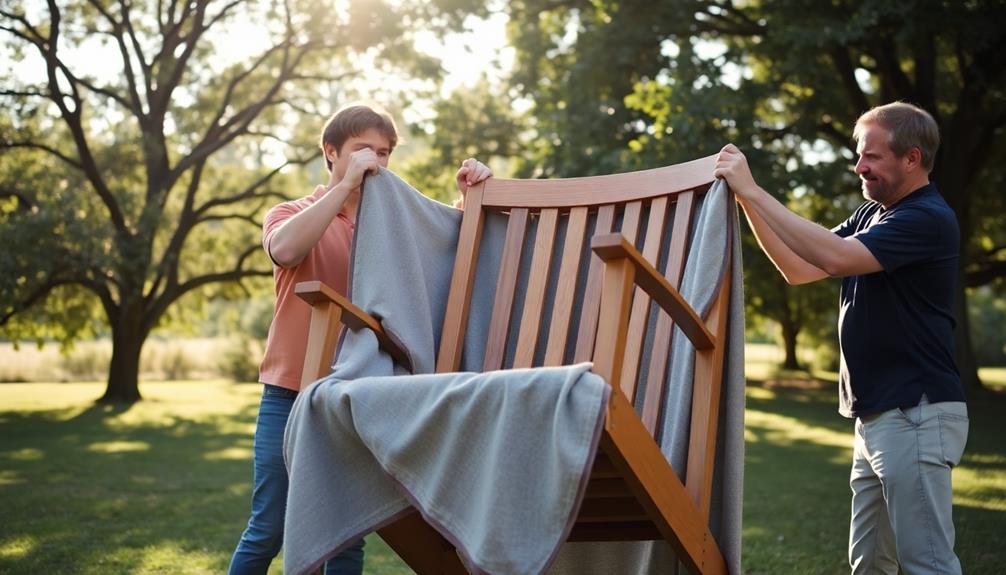
When moving your teak furniture, always lift it instead of dragging to prevent damage.
Take a moment to assess the structure and identify any detachable parts that can make the move easier.
Don't forget to clear your pathway of obstacles to guarantee a safe and smooth changeover.
Lifting, Not Dragging
Moving teak outdoor furniture requires care, as lifting it instead of dragging is vital for maintaining its beautiful finish. Dragging can cause friction damage and scratches that mar the wood's surface. To lift safely, assess the structure of your furniture first. Look for detachable parts or strong points to grip, guaranteeing a secure hold.
Before you start moving, it's important to clear the pathway of any obstacles. This helps you avoid accidents and guarantees a smooth relocation process. If you're dealing with heavy items, don't hesitate to seek assistance. This will prevent strain and potential injury, making the task safer and more efficient.
Here are some tips to keep in mind while lifting:
- Plan your route: Know where you're going and avoid sudden movements.
- Use your legs: Bend at the knees, not your back, to lift properly.
- Communicate with helpers: If you have assistance, coordinate your movements.
- Mind the temperatures: Avoid placing the furniture in direct sunlight or near heaters to preserve its integrity.
Clear Pathway Assessment
A clear pathway is essential for safely relocating your teak outdoor furniture. Before you start, perform a clear pathway assessment to identify any obstacles like plants, furniture, or decorative items that could cause accidents. This preparation prevents unnecessary struggles during the move.
| Key Considerations | Actions to Take |
|---|---|
| Identify Obstacles | Look for plants, furniture, or decor |
| Strong Points | Find sturdy parts to lift from |
| Prepare Placement Spot | Set the area before moving furniture |
Always lift furniture rather than dragging it to prevent friction damage and structural damage to your teak. If you're dealing with heavy pieces, don't hesitate to ask for help. This not only reduces the risk of injury but also maintains the integrity of the furniture during the process.
Additionally, aim to move your teak furniture in moderate temperatures, avoiding direct sunlight. This helps preserve the wood's integrity and keeps it looking beautiful for years to come. By following these safe moving techniques, you'll guarantee a smooth shift for your outdoor furniture.
Furniture Structure Evaluation
Evaluating the structure of your teak furniture is essential for a safe move. Start by checking for detachable parts, like cushions or tabletops, which can make the moving process easier. Identify strong points on the furniture to lift from, guaranteeing you have a secure grip.
Here are some tips to keep in mind:
- Use a lifting technique to minimize strain and avoid friction damage.
- Clear obstacles from your pathway to prevent accidents.
- If you're dealing with heavy items, don't hesitate to ask for help.
- Always handle teak furniture gently to maintain its integrity.
When moving your furniture, remember that dragging or pulling can create scratches and dents, diminishing its beauty.
By taking the time to perform a thorough furniture structure evaluation, you'll guarantee a smooth shift without compromising the quality of your outdoor pieces. Keep in mind that a little preparation goes a long way in preserving the natural elegance of your teak furniture.
Teak Preservation Methods
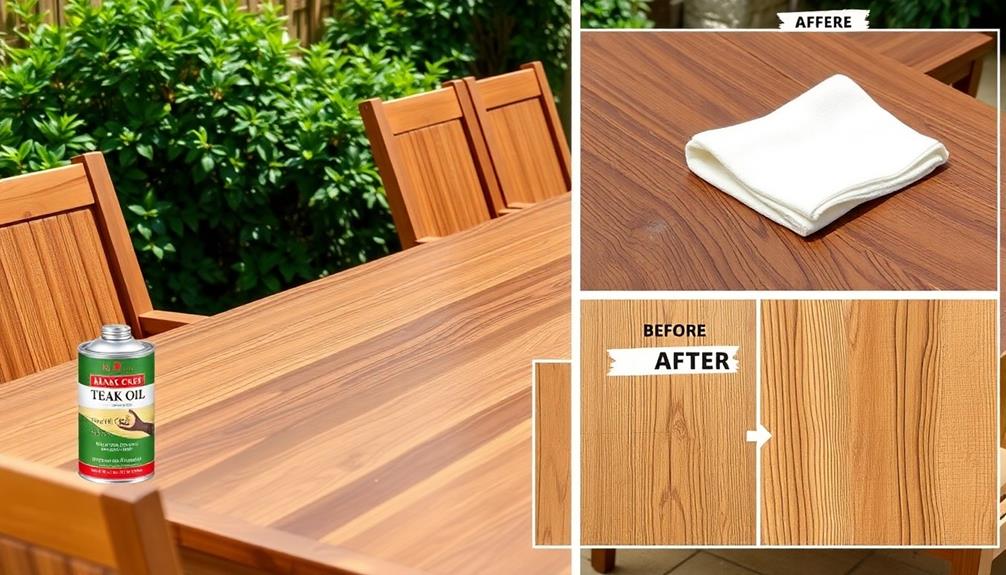
Five effective teak preservation methods can help keep your outdoor furniture looking beautiful and lasting for years.
First, apply teak sealers every 6 to 12 months. These sealers preserve the wood's natural oils, protect against UV radiation, and maintain its golden color. Avoid using teak oils, as they can create maintenance issues without offering lasting protection.
Second, regularly clean teak furniture with a mild soap and water solution. This simple step prevents dirt buildup and potential staining, enhancing the longevity of your teak outdoor furniture.
Third, always cover your furniture during inclement weather. This protects the wood from moisture damage and mold growth.
Fourth, if you notice surface stains or a dull finish, consider lightly sanding the surface. This periodic action can restore the original look of your furniture, but be cautious not to damage the wood. In addition, always use fine-grit sandpaper to avoid unnecessary scratches and preserve the wood’s natural beauty. After sanding, wipe down the surface with a clean cloth to remove any dust before applying a protective finish. If you’re thinking of disposing of old furniture, consider donating or recycling it, as many pieces can find a second life in someone else’s space or be repurposed in creative ways. Additionally, when deciding *how to get rid of furniture*, it’s important to research local disposal guidelines, as different areas may have specific rules for recycling or throwing away large items. By opting to donate or recycle, you not only declutter your space but also contribute to reducing waste in landfills, promoting sustainability in the process.
Finally, inspect your furniture regularly for any signs of wear or damage. Early detection allows you to take action before problems worsen.
Seasonal Maintenance Tips
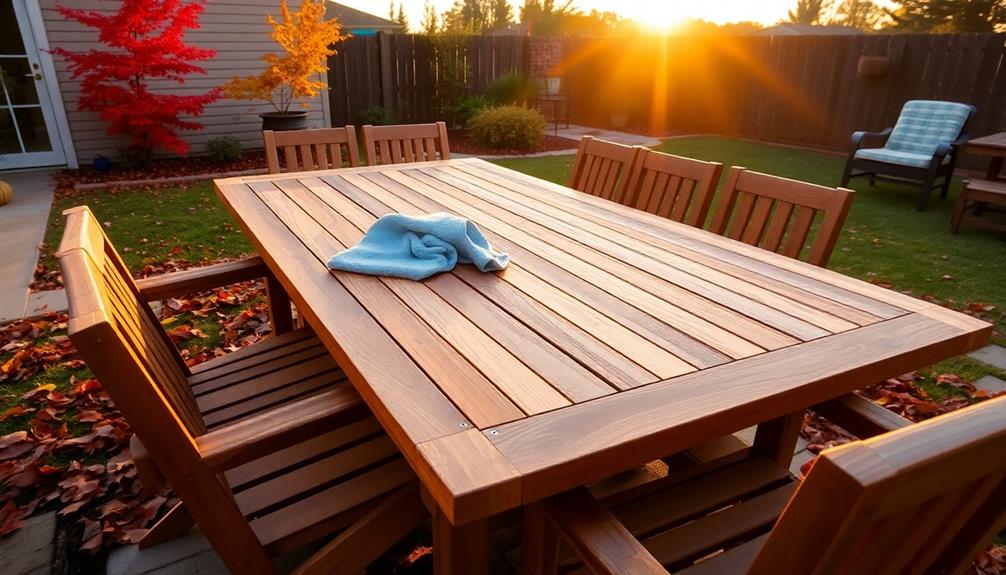
After implementing effective teak preservation methods, seasonal maintenance becomes key to keeping your outdoor furniture in top shape. Each season presents unique challenges, so it's crucial to adapt your clean and care routine accordingly.
- Spring: Clean and inspect your teak furniture for any winter damage. Remove debris and check for mold and mildew before using it again.
- Summer: Regularly check for signs of fading or damage due to UV exposure. Consider using protective covers when not in use to minimize wear.
- Fall: Clear leaves and debris from your teak furniture to prevent moisture buildup. This helps avoid mold and discoloration over time.
- Winter: Thoroughly clean your furniture and make certain it's dry before covering or storing it indoors. This prevents moisture damage and mildew growth.
Additionally, periodically check the condition of your protective covers throughout the seasons. Make sure they fit securely and allow airflow, preventing trapped moisture and mildew.
Understanding Natural Aging
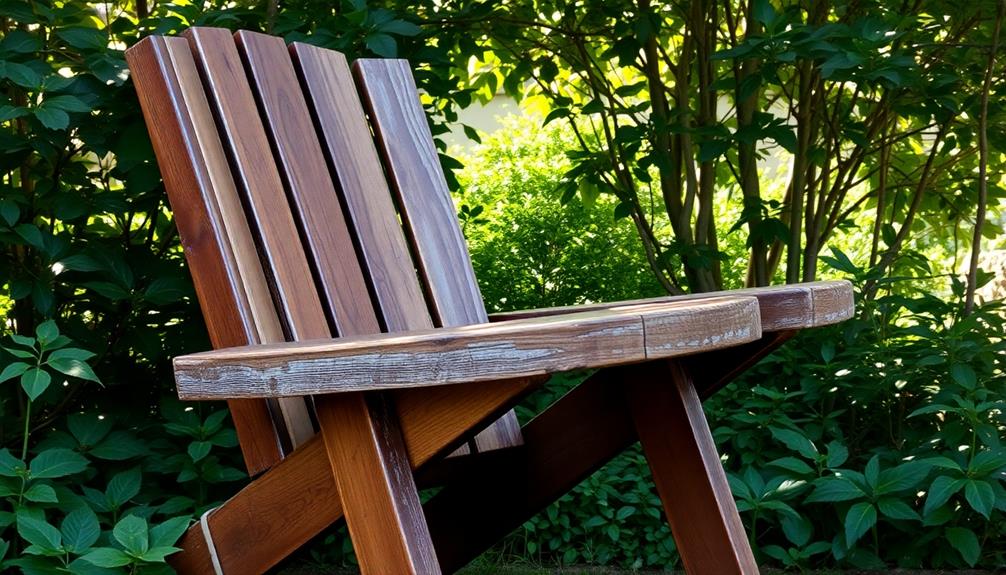
Teak outdoor furniture undergoes a fascinating transformation over time, shifting from its warm honey-brown hue to a striking silver-gray patina. This change results from the natural aging process, where the wood's natural oils evaporate due to exposure to the elements.
Generally, within 9 to 12 months, untreated teak will develop this beautiful silver-gray color, which doesn't compromise its structural integrity.
Keep in mind that environmental conditions, such as sunlight and humidity, can accelerate this aging effect. As your teak furniture matures, you might notice fine cracks appearing on the wood surface. Don't worry; these cracks are normal and reflect the wood's natural characteristics rather than a sign of deterioration.
Many people appreciate the unique aesthetic of aged teak, as the silver-gray patina enhances the beauty of outdoor furniture while still providing durability.
If you prefer the original warmth of teak, you can choose to apply treatments, but recognizing and embracing the natural aging process can lead to a stunning, timeless outdoor space. Understanding this evolution helps you appreciate the enduring quality and charm of your teak furniture.
Teak Oil vs. Teak Sealer
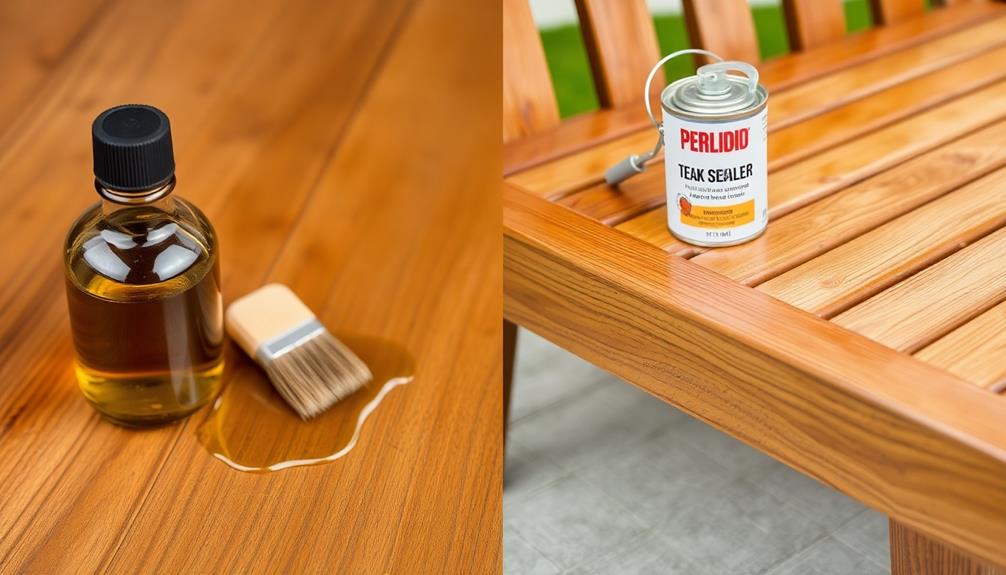
When it comes to protecting your teak outdoor furniture, understanding the differences between teak oil and teak sealer is essential.
Teak oil enhances gloss but needs more frequent applications, while teak sealers offer longer-lasting protection and maintain that beautiful golden color.
Consider how often you're willing to reapply and what kind of protection you want for your furniture.
Protection Duration Comparison
Choosing between teak oil and teak sealer for your outdoor furniture can greatly impact its protection duration.
Teak oil typically requires reapplication every 6 months to 1 year, providing only temporary protection against water and UV rays. While it enhances surface gloss, it doesn't prevent the wood from graying.
On the other hand, teak sealers can last from 1 to 2 years, helping to maintain the original honey color of your furniture while offering stronger defense against moisture and UV radiation.
Here's a quick comparison for you:
- Teak oil: Shorter protection duration, needs more frequent maintenance.
- Teak sealers: Longer-lasting protection, requiring less frequent applications.
- Aesthetic benefits: Sealers preserve original color better than oils.
- Natural oils: Oils enhance gloss but may lead to quicker aging.
Application Frequency Differences
Understanding the differences in application frequency between teak oil and teak sealer is vital to maintaining your outdoor furniture effectively. Teak oil should be applied every 6 months to 1 year for ideal protection, while teak sealer typically lasts about a year, requiring reapplication annually or bi-annually. This distinction is essential for ensuring your furniture remains in top shape.
Teak oil provides temporary protection against water and rot but doesn't offer long-lasting UV protection. It enhances the surface gloss of your outdoor furniture, but it won't greatly extend its lifespan.
On the other hand, teak sealer preserves both the appearance and durability of the wood over time, maintaining its natural golden color.
One important consideration is the waiting period after applying teak oil. If you plan to seal afterward, this step is necessary to prevent mildew growth, which can be a challenge when using natural oils like teak oil.
Ultimately, for long-term protection and lower maintenance issues, teak sealer is often the better choice, providing effective UV protection and a longer-lasting finish for your outdoor furniture.
Proper Storage Solutions
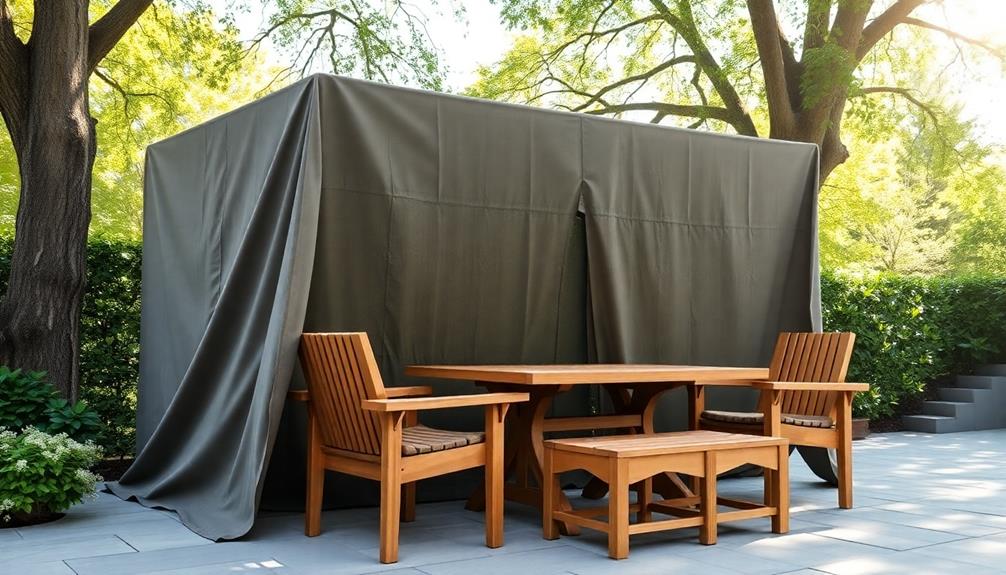
Properly storing your teak outdoor furniture is essential to maintaining its beauty and durability. By following some proper storage solutions, you can greatly enhance the longevity of your teak furniture.
Start by choosing a dry, cool place away from direct sunlight and heaters, as excessive heat can cause the wood to dry out and crack. If indoor storage isn't an option, invest in high-quality waterproof covers that allow for ventilation, protecting against moisture damage.
Here are some quick tips to think about:
- Always make sure your furniture is clean and dry before storing it to minimize mold and mildew risks.
- During winter, use elevated furniture storage methods like pallets or blocks to keep it off the ground and prevent contact with snow or standing water.
- Regularly inspect stored furniture for any signs of wear or damage, addressing issues promptly to maintain its integrity.
- Reflect on rotating pieces to avoid uneven fading or wear.
Protecting Against Mildew
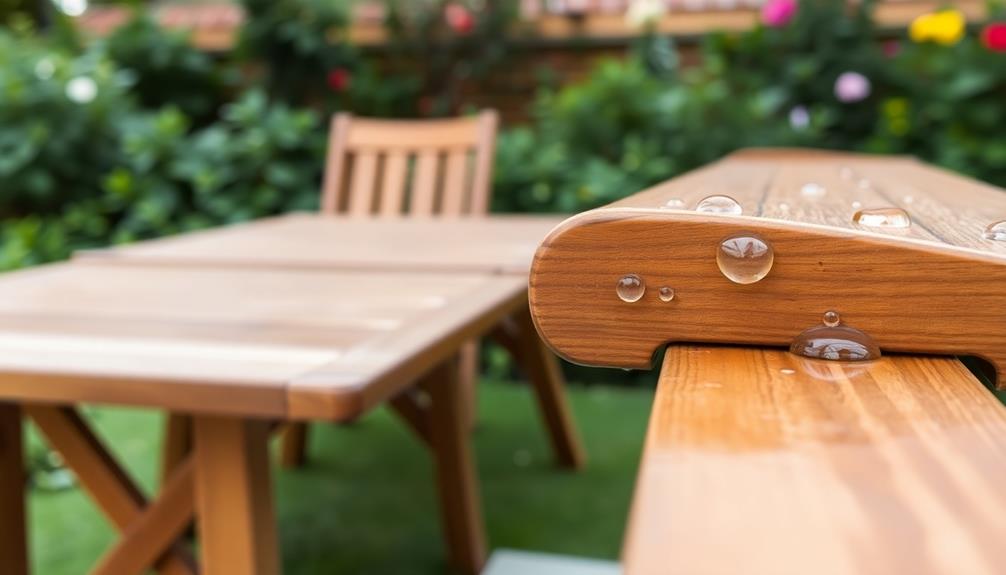
Storing your teak outdoor furniture correctly sets the foundation for protecting it against mildew. Regularly inspect your teak furniture for signs of mildew, especially in humid conditions. Damp surfaces can encourage mildew growth, so it's essential to act promptly.
Remove any debris, like leaves and dirt, from the surface to minimize moisture retention and help prevent mildew formation.
If you spot existing mildew, use a solution of water and bleach to clean the wood effectively. Rinse thoroughly afterward to avoid any residue that could harm the finish.
Avoid covering damp teak furniture, as trapped moisture can lead to mildew; always make sure the furniture is completely dry before applying protective covers.
To further protect against mildew, apply a high-quality teak sealer every 6 to 12 months. This not only guards against UV damage but also helps repel moisture, making it easier to prevent mildew growth.
Professional Restoration Services
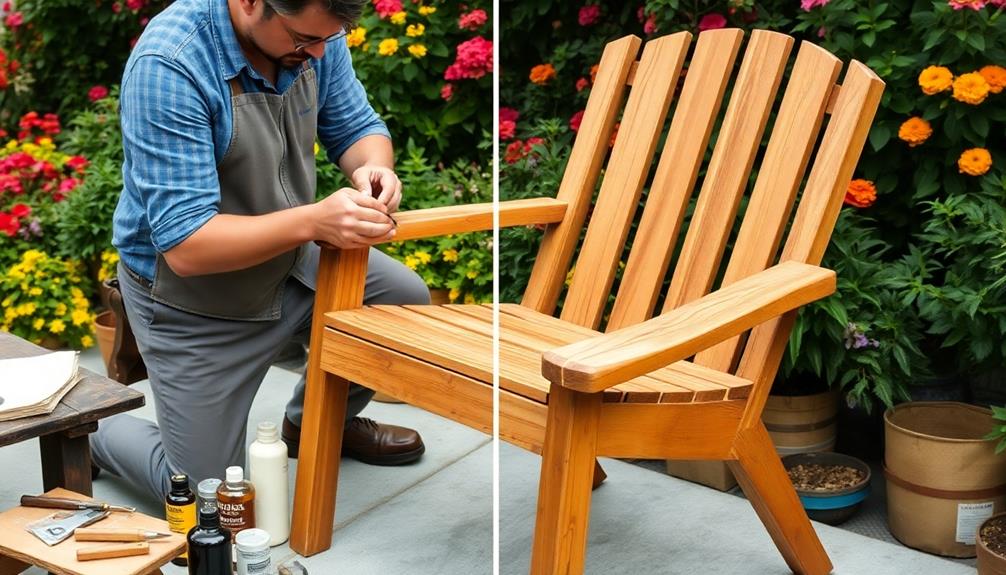
When your teak outdoor furniture shows signs of wear or damage, turning to professional restoration services can make all the difference.
These experts specialize in cleaning, sealing, and repairing your teak furniture, ensuring it remains both beautiful and functional for years to come.
Consider these benefits of using professional restoration services:
- Early Damage Detection: Regular inspections can spot mold, mildew, or structural issues before they worsen.
- Refinishing Techniques: Professionals use advanced refinishing techniques to restore your furniture's original color and finish.
- Tailored Maintenance Plans: They can create customized maintenance plans to suit your specific environmental conditions.
- High-Quality Materials: Using only high-quality materials and techniques, they extend the life of your teak furniture while preserving its value.
Frequently Asked Questions
Does Outdoor Teak Furniture Need to Be Oiled?
Outdoor teak furniture doesn't necessarily need oil. It contains natural oils for protection. However, if you want to enhance its appearance and maintain color, applying teak oil every 6 to 12 months is beneficial.
Does Outdoor Teak Furniture Need to Be Sealed?
If you want your outdoor teak furniture to withstand the wrath of nature, you've got to seal it! Sealing protects its beauty, prevents damage, and keeps it looking stunning. Don't skip this vital step!
How Do You Care for Weathered Teak Outdoor Furniture?
To care for weathered teak, clean it with soapy water and a stiff brush, sand lightly to refresh the wood, and apply a quality teak sealer every 6 to 12 months for protection.
Should You Sand Outdoor Teak Furniture?
Imagine a painter restoring a canvas. If your outdoor teak furniture's surface feels rough or looks faded, light sanding can revive its beauty. Just remember to follow the grain and clean it afterward for best results.
Conclusion
Caring for your teak outdoor furniture might seem like a hassle, but it's worth it for the beauty and longevity it brings to your space. By following these simple maintenance tips, you can keep your furniture looking stunning with minimal effort. Don't worry if you're short on time; even a little attention goes a long way. Embrace the charm of teak and enjoy your outdoor oasis without the stress—your furniture will thank you for it!
